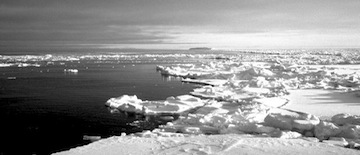
Research
A general theme of much of our research is to use physical modeling and mathematical methods to address societally relevant problems. We use a variety of models ranging from idealized mathematical representations of physical climate phenomena that can be developed and analyzed with pencil and paper to comprehensive climate models that are run on massive supercomputers. Our work also draws on analysis of observations. Much of this work focuses on investigating physical mechanisms in the climate system. A selection of specific research themes are briefly described below. See our publications for a more detailed picture of our research.
Sea ice
Arctic sea ice is one of the components of the climate system that has changed most rapidly during recent decades, and it is projected to continue to change rapidly during the coming century. Meanwhile, the Antarctic sea ice cover has expanded during much of the era of satellite measurements. One of the goals of our research is to develop physical theories to explain how the sea ice cover in both hemispheres interacts with other components of the climate system and how it responds to climate changes. Related areas of our research include investigating the possibility of bifurcation thresholds ("tipping points") during sea ice retreat due to the ice-albedo feedback or due to heat mixed up from the depths of the Arctic Ocean, biases in comprehensive climate model simulations of Arctic and Antarctic sea ice changes, uncertainty in satellite-derived sea ice observations, and other topics.
Climate feedbacks
The response of the global climate system to greenhouse-driven radiative forcing is mediated by climate feedbacks. Our research on this topic includes investigating the dependence of these feedbacks on the underlying climate itself (with relevance to using paleoclimate reconstructions to constrain the sensitivity of the modern climate), explaining changes in ocean heat transport into the Arctic as the climate warms, assessing the impact of atmospheric/radiative feedbacks on the Arctic amplification of global warming, using satellite-derived observations to determine the upper limit on heating due to the ice-albedo feedback, and other topics.
Dynamics of the ocean and atmosphere and climate
Our research also involves other aspects of ocean and atmosphere dynamics, including investigating factors that determine the regional structure of sea level rise and associated changes in ocean circulation, constraints on the depth of the ocean overturning circulation, mechanisms for changes in ocean heat transport near the Antarctic margins, snowpack variations under global warming, interactions between atmospheric and oceanic energy transport, tropical monsoons, El Niño, and other topics.
Icebergs
The calving of icebergs into the polar oceans from Antarctic and Greenland glaciers has increased during recent decades. Projections suggest that this will continue to increase during the coming century, perhaps dramatically. Icebergs can play an important role in the climate system by releasing freshwater into the upper ocean, which influences ocean circulation through its effect on seawater density. We have worked on developing and analyzing physical models, as well as observations, in order to build understanding of the drift, decay, fracturing, and capsizing of icebergs and their role in the modern climate system, as well as their role in paleoclimate phenomena and projected future climates.
Paleoclimate
The Last Glacial Maximum, which occurred approximately 21,000 years ago, provides a relatively recent example of a markedly different climate. Our research aims to build understanding of the modern climate and future climate changes by investigating physical mechanisms for differences in the climate system at the Last Glacial Maximum compared with today, including how the global ocean circulation was altered. Additionally, the transition from the Last Glacial Maximum to modern conditions was interrupted by a 1500-year cold period known as the Younger Dryas, which is one of the most dramatic incidents of past abrupt climate change reconstructed from paleoclimate proxy records, and we have worked on understanding the mechanism that caused this. Our other paleoclimate research has investigated a range of phenomena, including massive iceberg discharge events during the last glacial period ("Heinrich Events"), the Late Ordovician glaciation 450 million years ago and accompanying mass extinction, the global glaciation hypothesized to have occurred 650 million years ago ("Snowball Earth"), the response of atmospheric circulation to past changes in incident solar radiation associated with variations in earth's orbit, and other phenomena.
Although our research does not directly involve field work, there have been occasional opportunites to take part in research in the field (here are some photos), and students and postdocs in the group have carried out field work with other faculty members.